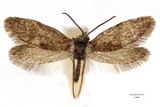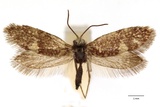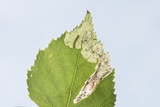Eriocrania salopiella (Stainton, 1854) Species
Last modified: Nov. 2, 2024, 12:16 p.m.
This species was mentioned for the first time in Belgium in 2009. Nowadays dispersed throughout the country but still rare.
Details
- Classification
- Family: Eriocraniidae > Genus: Eriocrania > Species: Eriocrania salopiella
- Vernacular names
- Geelkoppurpermot (NL), Small Birch Purple (EN), Gelbkopf-Purpurmotte (DE)
- First mention in Belgium
- Wullaert S. 2010c. Eriocrania salopiella (Lepidoptera: Eriocraniidae), new to the Belgian fauna. — Phegea 38(4): 125–127. On page 125 (as Eriocrania salopiella Stainton, 1854). view page
- Status
-
Native
Distribution
Caterpillar
The white caterpillar has a pale brown head.
Mine
The mine starts as a narrow gallery that is completely filled with black frass. Soon this gallery turns into a blotch mine that can cover the entire side of a leaf. Usually, the mine starts on one side, crosses the main vein, and continues on the other side of this vein.
See also bladmineerders.be
Bionomics
The egg is laid in the leaf close to the main vein. The larva constructs a mine that starts as a narrow gallery that is completely filled with black frass. Soon this gallery turns into a blotch mine that can cover the entire side of a leaf. Usually, the mine starts on one side, crosses the main vein, and continues on the other side of this vein. In this blotch mine, the frass is visible as long spaghetti-like threads. This species pupates in a tough silken cocoon in the soil or debris.
The adult moths can be observed resting on trees or flying around trees in sunshine. They occasionally come to light too.
Flight periods
The adults fly from late April till the end of May.
Observed on
- Host plant (species):
- Betula pendula and Betula pubescens
The monophagous larva feeds on Betula spp.



